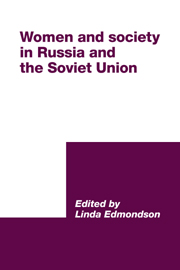Book contents
- Frontmatter
- Contents
- Notes on contributors
- Preface
- Introduction
- 1 ‘Better halves’? Representations of women in Russian urban popular entertainments, 1870-1910
- 2 The Silver Age: highpoint for women?
- 3 Women pharmacists in Russia before World War I: women's emancipation, feminism, professionalization, nationalism and class conflict
- 4 Women's rights, civil rights and the debate over citizenship in the 1905 Revolution
- 5 Laying the foundations of democracy in Russia: E. D. Kuskova's contribution, February–October 1917
- 6 Mariia L. Bochkareva and the Russian amazons of 1917
- 7 Russian women writers: an overview. Post-revolutionary dispersion and adjustment
- 8 Victim or villain? Prostitution in post-revolutionary Russia
- 9 Young women and perestroika
- 10 Glasnost and the woman question
- Index
8 - Victim or villain? Prostitution in post-revolutionary Russia
Published online by Cambridge University Press: 22 October 2009
- Frontmatter
- Contents
- Notes on contributors
- Preface
- Introduction
- 1 ‘Better halves’? Representations of women in Russian urban popular entertainments, 1870-1910
- 2 The Silver Age: highpoint for women?
- 3 Women pharmacists in Russia before World War I: women's emancipation, feminism, professionalization, nationalism and class conflict
- 4 Women's rights, civil rights and the debate over citizenship in the 1905 Revolution
- 5 Laying the foundations of democracy in Russia: E. D. Kuskova's contribution, February–October 1917
- 6 Mariia L. Bochkareva and the Russian amazons of 1917
- 7 Russian women writers: an overview. Post-revolutionary dispersion and adjustment
- 8 Victim or villain? Prostitution in post-revolutionary Russia
- 9 Young women and perestroika
- 10 Glasnost and the woman question
- Index
Summary
One of the posters produced in the early 1920s by the Moscow Provincial Soviet of Trade Unions shows a grim industrial town, and a crowd of downtrodden women shuffling from left to right, shawls round their shoulders, kerchiefs over their heads; in the foreground a group of plump men of the bourgeoisie stand and leer. Its central characters are a young man and a young woman: he, disproportionately large, holds in his left hand a hammer, sign of his membership of the proletariat; she, small-scale and dejected, is clearly in need of assistance – and indeed, the worker is holding out his free arm to her in a gesture of fraternal solicitude. The text reinforces this visual image of the prostitute as victim: ‘By destroying capitalism the proletariat destroys prostitution. Prostitution is a great misfortune for humanity. Worker take care of the woman worker.’ The date of publication was 1923, two years after the introduction of the New Economic Policy; the country was still recovering from the economic and social chaos of revolution, civil war and famine, and for the working class faced with a housing crisis, low wages and high unemployment, life was hard. It was particularly hard for women, many of whom had to support themselves and their families in conditions of a shrinking job market. The alarming level of redundancies among the female labour force appeared, albeit as a minor item, on party and trade union agendas.
- Type
- Chapter
- Information
- Women and Society in Russia and the Soviet Union , pp. 160 - 177Publisher: Cambridge University PressPrint publication year: 1992
- 3
- Cited by

